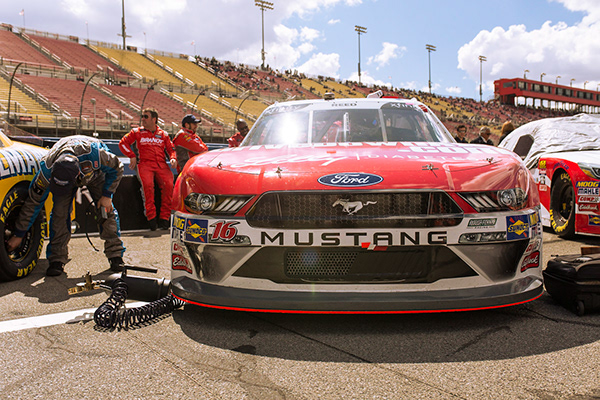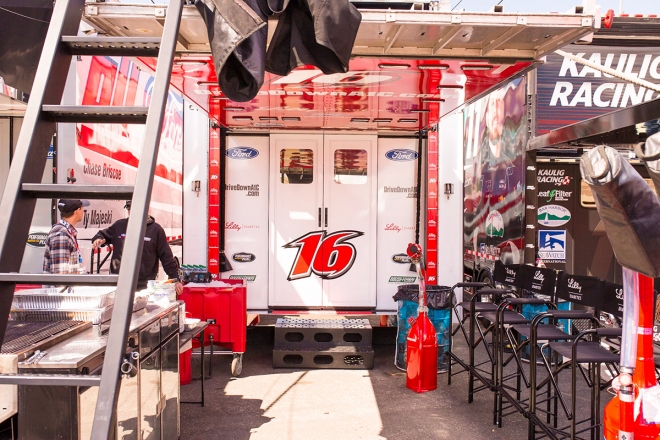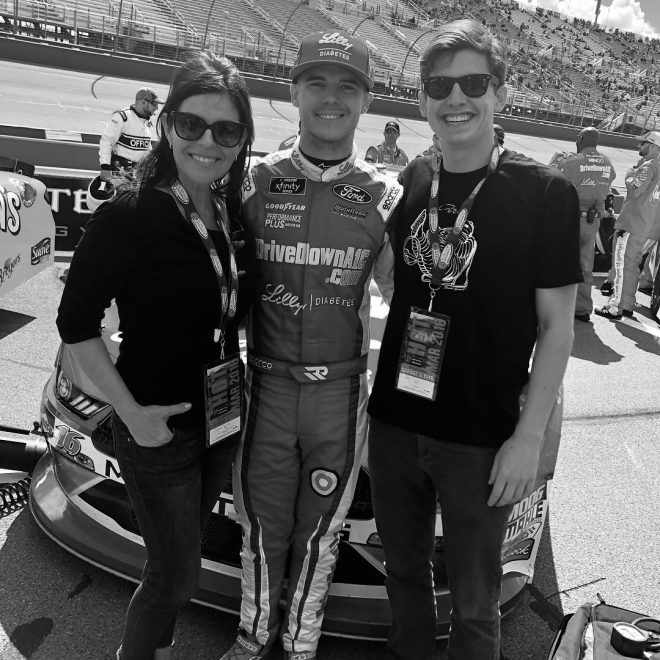Getting To Know Ryan Reed
Editor’s Note: Listen to the entire interview with Ryan Reed to find out more on his management and how he decided to not let his diagnosis stop him from racing.
Growing up in Bakersfield California, racing was like a part of the DNA of the tight-knit Reed household. When most kids were learning to ride a tricycle, Ryan Reed, like his grandfather and father, was racing, and Sundays were for NASCAR. Shortly after graduating high school and moving to Charlotte, North Carolina to pursue racing professionally at 17, Ryan’s career almost came to a screeching halt.
Toward the end of 2010, Ryan recalls feeling sick, noticing mild symptoms, but continued working in the race shop getting ready for his debut season. When he arrived home for a quick visit in early 2011, his extreme weight loss was obvious to his parents and a general physician diagnosed Ryan with type 1 diabetes on the spot. Growing up he remembers knowing a boy who took insulin shots, but that was really all he knew. When asked about how this would affect racing he was told, “‘Look, you’re never going to race again. You have to focus on living … ‘ What they said was a ‘Normal life with diabetes,’ which without racing, wasn’t normal to me. You know that (racing) was my life.”

“I had nowhere to turn. I didn’t know anything about it and I never even really known of any athletes or anybody that was living with the disease. So, I just kind of took the doctor’s word for it and man, I guess I’m done racing, you know. I mean, I say it kind of nonchalant, but it was devastating to me and my family.” Ryan squeezed his way onto famed endocrinologist Anne Peters‘ schedule, who had worked with several high profile athletes.
“As soon as I walked in the door, Anne changed everything for me. You know, her mentality towards diabetes and her approach to it and it was the first time anybody had instilled confidence in me that I could not only, you know, survive and live with diabetes, but also, continue to chase my dreams. And really, you know, attack it, kind of, instead of just trying to deal it and you know, get by day in and day out. It was, take the disease head on and try to really continue to chase my dreams and do everything that I wanted to do.”
People say when you become type 1, you need to approach the disease like a scientist. You’ve got to gather information, try out different strategies to see what will work. Ryan now had an entirely new disease to try to balance on top of everything else when racing. “I remember my first three, four, five races back, I kind of had to learn how to re-race, shift my mental approach and be focused in the car, while being able to be mentally present, dealing with and managing my diabetes. So, it was just incredibly different, and a lot to take on.”
Today, Ryan drives for Roush Fenway Racing, Number 16, Ford Mustang, with his Dexcom Continuous Glucose Monitor (CGM) monitor mounted next to his steering wheel. “I now know what my blood sugar is at all times, throughout the race. Between Anne and NASCAR, and the team people that I had around me, it was just inspiring to me. You know, and it made me so passionate and so much more driven than I’d ever been to see all that hard work and to see the dedication from everyone that had their hands on it. Ultimately, made me a better race car driver, better athlete and just way more focused on and off the racetrack.”

Being in the zone before a race requires a lot of mental discipline and before he heads to the track Ryan makes his way through the “Fan Zone” where people are screaming his name, waving photos for autographs, shouting for selfies. He breezes through with an effortlessness of a seasoned professional, but days of physical and mental prep have gone into race day.
“An hour before the race is when, for me, is when I really have to be dialed in. You know, for me, starting the race between about 5.0 to 6.7 mmol/L90 to 120 mg/dL is crucial because of the heat and the adrenaline. You know, it’s inevitable not to get a least a little bit dehydrated in those cars because 130 to 150°F temperatures are so common in there. So, you’re doing to lose quite a bit of water weight and quite a bit of hydration, so with that, my blood sugar goes up. Every race, I have to be very present. I can’t get relaxed, I mean there’s this potential for disaster.”
Racing is truly a team sport, and watching from the pit, witnessing Ryan screech into his team for tire changes and engine tune ups is like watching a mini speed race. Keeping an eye on his blood sugars is also part of the team’s responsibility. Manager Tony Mangini says going low isn’t something they worry about with Ryan, thanks in part to all the adrenaline, but there is a special feature to Ryan’s fire suit. A bullseye on the upper leg of his suit made of a thinner, fireproof material would allow the team to give him an insulin injection during a pit stop if needed.

“We practice it. Thankfully we’ve never had to do it during the race because it is more of a safety net. That’s something that we implemented early on and helped guide us through that. It’s pretty cool. If I needed to radio in, key in and say, ‘Hey, guys. I need X amount of insulin. I’m going to come down in five laps’ we can get tires, fuel, do a normal pit stop and then also get an insulin injection in the process.”
Much like racing, type 1 is also best with a team. “It’s so funny because there are so many natural comparisons there. Whether you’re talking about the guys that go over the wall and put tires and fuel in the car or my manager who makes all the decisions and guides the team or if you’re talking about all of the people that help me manage my diabetes and make sure that I’m on top of it and healthy and ready to compete day in and day out.
“I think that my crew chief is the guy, right? He’s the decision maker. He’s the guy who runs the team, makes sure that we’re making all the right decisions, pit strategy, setup, everything that goes on with that race car. He’s a lot like my endocrinologist, (Anne Peters) she’s so involved and she’s guided us and makes sure that we’re making the right decisions and that I know exactly what’s going on with my diabetes. If I need to make an adjustment she is the one who is in charge of guiding that and making the right decision there. That’s one example of that kind of A to B comparison between racing and diabetes.”
Last year Ryan was part of the Beyond Type 1 “Live Beyond” Instagram campaign. Part of his statement read, “I live beyond by never letting diabetes win. I put my helmet on, I strap in, I monitor my CGM, and I race.” Ryan does race and in 2015, Ryan became the documented first type 1 to win a NASCAR top series race at Daytona and another win there in 2017.
“Those are pretty special, especially the 2015 one. My first NASCAR win. I see that interview a lot. I was 21 or 22 at the time, I was just so emotional in Victory Lane. The first thing I talked about was getting diagnosed and being told I’d never race again and just all the struggles to get to that point. I really wanted to take that opportunity to use that platform and that stage and that moment to just say do not give up on your dreams and don’t let diabetes stop you. For me, that moment in Victory Lane with that camera in front of me it was kind of just an accumulation of all of the struggle and all the hard work.”
“The day in and day out grind of having diabetes and the highs and lows literally and figuratively that are a part of your life is challenging, and I think when people live with type 1 diabetes that they really know what it’s like to live that emotional struggle. When you’re able to rise above that and reach those moments and those victories throughout life it makes it all worth it and makes it so much more special.”

Anyone who lives with type 1 knows that it is a long race and can be incredibly frustrating. “I think when life is good when we’re winning races and the diabetes management seems easy and I’m doing what my doctor says and it’s working, you have those great days where it just seems like you carb count, you do all the things and you’re spot on. Just like with racing, there are times where it just seems like nothing you do is right. You work so hard and you put so much energy and time and dedication to it but it just seems to not be working out.”
“I think for me you talk about me smiling and being happy at the race track and relaxed, I’ve really just had to learn how to enjoy the process. I’m so fortunate and so blessed to be able to go out and chase my dreams and have the kind of people around me that are amazing, whether it’s friends and family, doctors, race team, the people that I see on social media that reach out and say that they pull for me on Saturday afternoons because they’re affected by diabetes.”
“All that stuff means so much to me and those are the things that truly help me dig out of those holes and fight through it and go to the gym and grind a little harder and dig a little deeper because the things I do off the race track and the time and energy I put into it those are what’s going to make the difference come race day. I just try to do the little things and pay attention to the things in life that are good and the victories in life and know that those are around the corner. Just stay the course and trust the process.”
Catch Ryan Reed’s entire interview HERE.
Read about Ryan Reed joining Beyond Type 1’s Global Ambassador Council.





